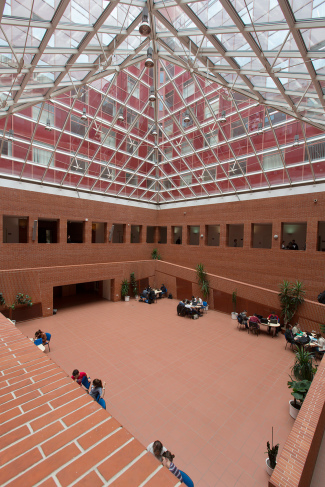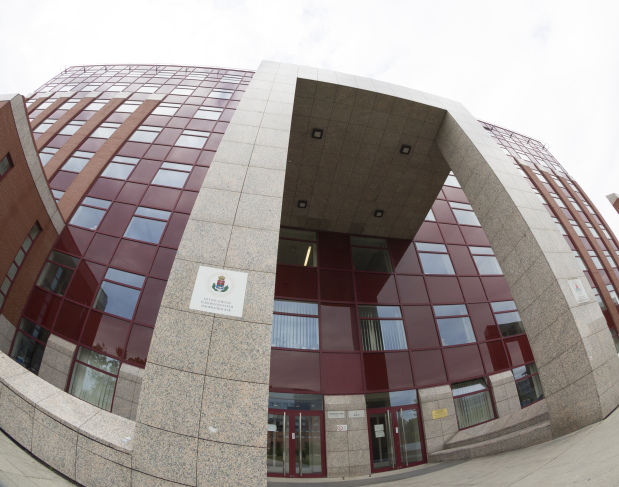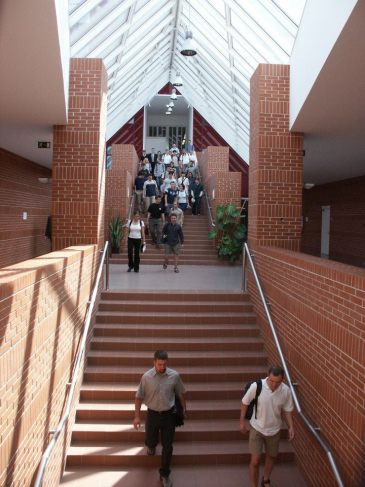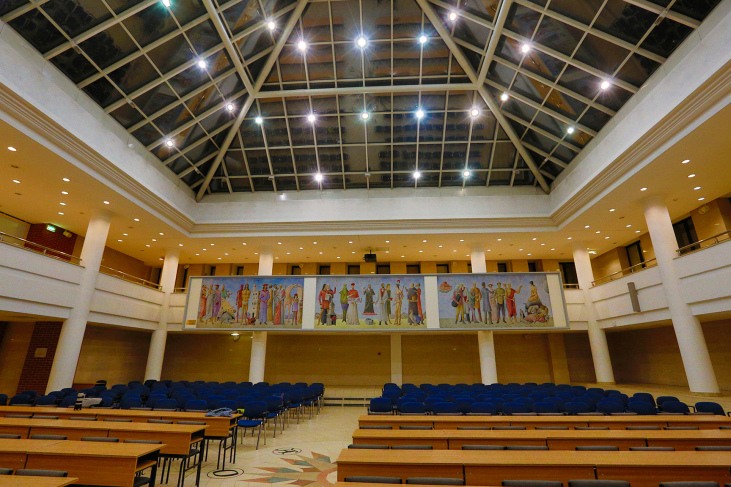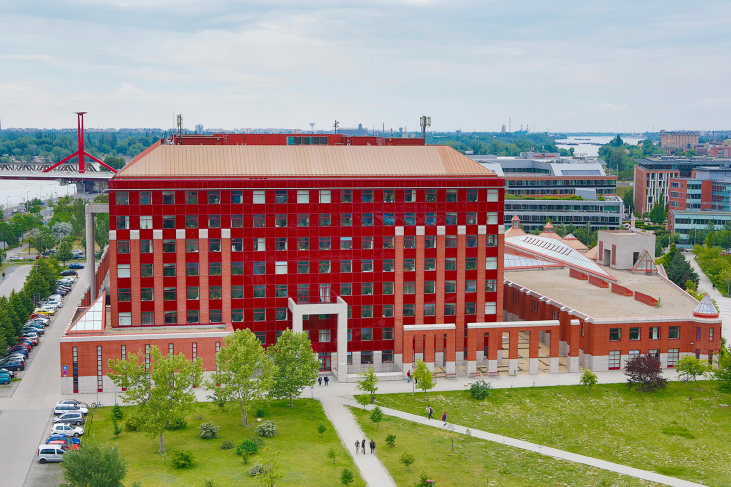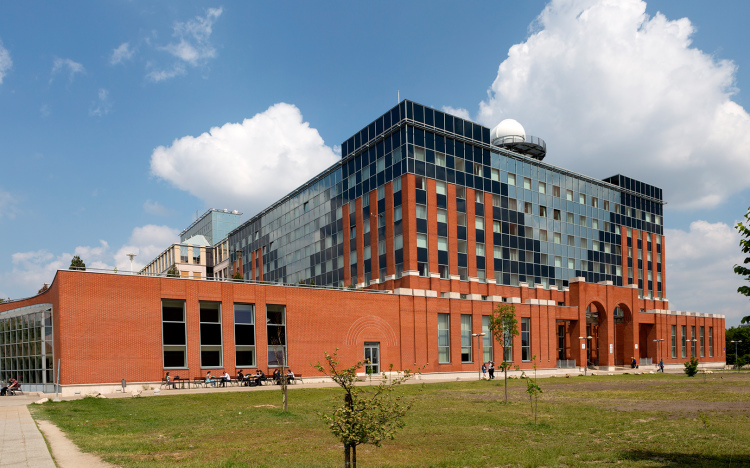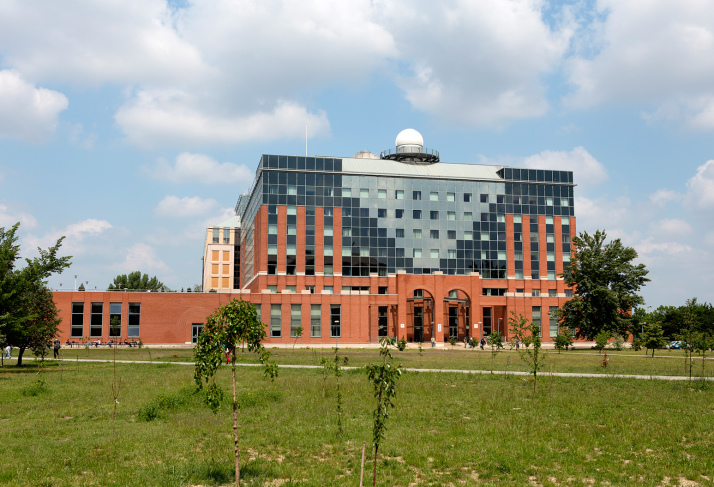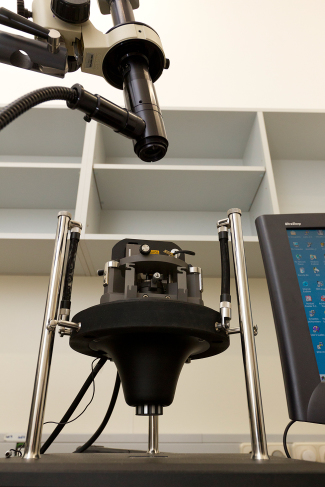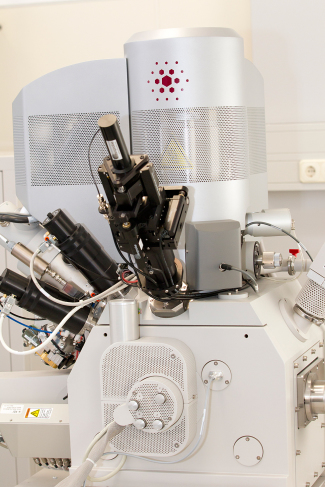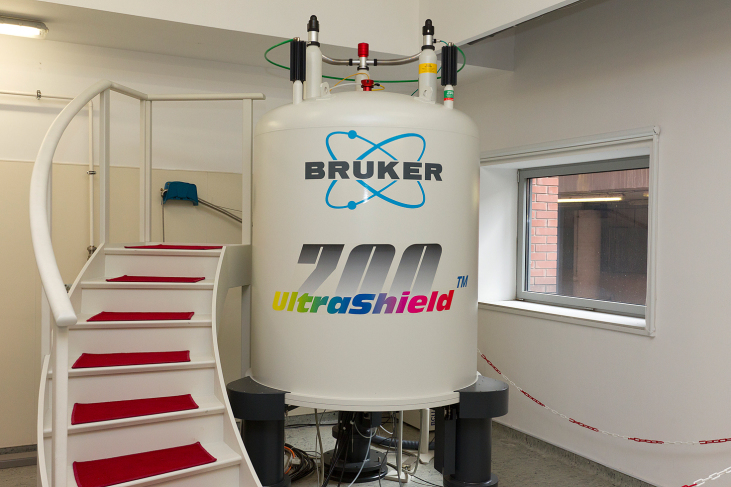Mathematics MSc

China

Algeria
Mathematics MSc
Mathematician
Degree program
Master
MAB2011/3/VII/6
English
4 semesters (2 years)
120
1
10
The program gives a comprehensive knowledge of several areas in mathematics and introduces the students into doing research in theoretical and/or applied mathematics. Besides purely theoretical courses, many courses are application oriented. Courses are offered in algebra, number theory, real and complex analysis, topology, geometry, probability theory and statistics, discrete mathematics and operations research but also in such interdisciplinary subjects as bioinformatics and theoretical computer science. The students may also choose from high-level application-oriented courses, which present state of the art issues of the given area, like complex systems, financial mathematics etc. The program is aimed at students who have at least a BSc degree in mathematics or a related field (physics, computer science, engineering etc.) In the latter case a certain number (65) of mathematical credits is required from earlier studes.
One of the main features of the program is the great variety of courses, covering several areas of mathematics. Our graduates will have a broad knowledge in many areas of mathematics. Besides offering introduction and basic foundation in many areas, some of the subjects lead to up-to-date research results.
Most of the teachers of the program have international teaching experience and they regularly give classes also at foreign universities, including North American institutions. Young mathematicians, bringing in freshness and new momentum, are also involved in the program. Our instructors all have scientific degrees and good research record. Examples show that graduating from our program is a very good starting point for doctoral or (at a later stage) postdoctoral studies.
Of particular interest is the fact that many researchers in the internationally renowned Hungarian school of combinatorics have started their career at our university and many of them still have position at the Institute of Mathematics. For example the Wolf Prize and Kyoto Prize winner Prof. László Lovász is a professor at our university. Recent Abel prize winner, Prof. Endre Szemerédi is also a graduate of our school. But one could also recall the Ostrowski Prize of Prof. Miklós Laczkovich (professor of our university), the Gödel Prize of Prof. László Babai (former professor), the Coxeter Prize of Prof. Balázs Szegedy (a graduate of our university) etc.
Basic courses
The basics of set theory, relations, functions, cardinality of sets, introduction of the real numbers, real sequences and their convergence, monotone sequences, partial limits, classical theorems of sequences, continuous functions, uniformly continuous functions, differentiable functions, mean value theorems, theorems of Riemann integrability, Jordan measure, null sets under Jordan and Lebesgue measure
- Basic group theory. Permutation groups. Lagrange’s Theorem. Homomorphisms and normal subgroups. Direct product, the Fundamental theorem of finite Abelian groups. Free groups and defining relations.
- Basic ring theory. Ideals. Chain conditions. Integral domains, PID’s, euclidean domains.
- Fields, field extensions. Algebraic and transcendental elements. Finite fields.
- Linear algebra. The eigenvalues, the characterisitic polynmial and the minimal polynomial of a linear transformation. The Jordan normal form. Transformations of Euclidean spaces. Normal and unitary transformations. Quadratic forms, Sylvester’s theorem.
- Non-euclidean geometries: Classical non-euclidean geometries and their models. Projective spaces. Transformation groups.
- Vector analysis: Differentiation, vector calculus in dimension 3. Classical integral theorems. Space curves, curvature and torsion.
- Basic topology: The notion of topological and metric spaces. Sequences and convergence. Compactness and connectedness. Fundamental group.
Complex differentiation. Power series. Elementary functions. Cauchy’s integral theorem and integral formula. Power series representation of regular functions. Laurent expansion. Isolated singularities. Maximum principle. Schwarz lemma and its applications. Residue theorem. Argument principle and its applications. Sequences of regular functions. Linear fractional transformations. Riemann’s conformal mapping theorem. Extension to the boundary. Reflection principle. Picard’s theorem. Mappings of polygons. Functions with prescribed singularities. Integral functions with prescribed zeros. Functions of finite order. Borel exceptional values. Harmonic functions. Dirichlet problem for a disc.
Smooth parameterized curves in the n-dimensional Euclidean space Rn. Arc length parameterization. Distinguished Frenet frame. Curvature functions, Frenet formulas. Fundamental theorem of the theory of curves. Signed curvature of a plane curve. Four vertex theorem. Theorems on total curvatures of closed curves.
Smooth hypersurfaces in Rn. Parameterizations. Tangent space at a point. First fundamental form. Normal curvature, Meusnier’s theorem. Weingarten mapping, principal curvatures and directions. Christoffel symbols. Compatibility equations. Theorema egregium. Fundamental theorem of the local theory of hypersurfaces. Geodesic curves.
Projective geometry: projective space over a field, projective subspaces, dual space, collineations, the Fundamental Theorem of Projective Geometry. Cross ratio. The theorems of Pappus and Desargues, and their rôle in the axiomatic foundations of projective geometry. Quadrics: polarity, projective classification, conic sections.
Hyperbolic geometry: Minkowski spacetime, the hyperboloid model, the Cayley-Klein model, the conformal models of Poincaré. The absolute notion of parallelism, cycles, hyperbolic trigonometry.
Topological spaces and continuous maps. Constructions of spaces: subspaces, quotient spaces, product spaces, functional spaces. Separation axioms, Urison’s lemma. Tietze theorem.Countability axioms., Urison’s metrization theorem. Compactness, compactifications, compact metric spaces. Connectivity, path-connectivity. Fundamental group, covering maps.
The fundamental theorem of Algebra, The hairy ball theorem, Borsuk-Ulam theorem.
- Probability space, random variables, distribution function, density function, expectation, variance, covariance, independence.
- Types of convergence: a.s., in probability, in Lp, weak. Uniform integrability.
- Characteristic function, central limit theorems.
- Conditional expectation, conditional probability, regular version of conditional distribution, conditional density function.
- Martingales, submartingales, limit theorem, regular martingales.
- Strong law of large numbers, series of independent random variables, the 3 series theorem.
- Statistical field, sufficiency, completeness.
- Fisher information. Informational inequality. Blackwell-Rao theorem. Point estimation: method of moments, maximum likelihood, Bayes estimators.
- Hypothesis testing, the likelihood ratio test,
...
Real functions. Functions of bounded variation. Riemann-Stieltjes integral, line integrals. The inverse and implicit function theorems. Optimum problems with constraints. Measure theory. The Lebesgue integral. Function spaces. Complex analysis. Cauchy's theorem and integral formula. Power series expansion of analytic functions. Isolated singular points, the residue theorem. Ordinary differential equations. Theorems on existence and uniqueness. Elementary methods. Linear equations and systems. Hilbert spaces, orthonormal systems. Metric spaces, basic topological concepts, sequences, limits and continuity of functions. Numerical methods.
Naive and axiomatic set theory. Subset, union, intersection, power set. Pair, ordered pair, Cartesian product, function. Cardinals, their comparison. Equivalence theorem. Operations with sets and cardinals. Identities, monotonicity. Cantor’s theorem. Russell’s paradox. Examples. Ordered sets, order types. Well ordered sets, ordinals. Examples. Segments. Ordinal comparison. Axiom of replacement. Successor, limit ordinals. Theorems on transfinite induction, recursion. Well ordering theorem. Trichotomy of cardinal comparison. Hamel basis, applications. Zorn lemma, Kuratowski lemma, Teichmüller-Tukey lemma. Alephs, collapse of cardinal arithmetic. Cofinality. Hausdorff’s theorem. Kőnig inequality. Properties of the power function. Axiom of foundation, the cumulative hierarchy. Stat
...
Core courses - Algebra and number theory
Group actions, permutation groups, automorphism groups. Semidirect products. Sylow’s Theorems.
Finite p-groups. Nilpotent groups. Solvable groups, Phillip Hall’s Theorems.
Free groups, presentations, group varieties. The Nielsen-Schreier Theorem.
Abelian groups. The Fundamental Theorem of finitely generated Abelian groups. Torsionfree groups.
Linear groups and linear representations. Semisimple modules and algebras. Irreducible representations. Characters, orthogonality relations. Induced representations, Frobenius reciprocity, Clifford’s Theorems.
Elements of multiplicative number theory. Dirichlet's theorem,special cases. Elements of combinatorial number theory. Diophantine equations. The two square problem. Gaussian integers, special quadraticextensions. Special cases of Fermat's last theorem. The four squareproblem, Waring's problem. Pell equations. Diophantine approximation theory. Algebraic and transcendent numbers. The circle problem, elements of the geometry of numbers. The generating function method, applications. Estimates involving primes. Elements of probabilistic number theory.
Asociative rings and algebras. Constructions: polynomials, formal power series, linear operators, group algebras, free algebras, tensor algebras, exterior algebras. Structure theory: the radical, direct and semidirect decompositions. Chain conditions. The Hilbert Basis Theorem, the Hopkins theorem.
Categories and functors. Algebraic and topological examples. Natural transformations. The concept of categorical equivalence. Covariant and contravariant functors. Properties of the Hom and tensor functors (for non-commutative rings). Adjoint functors. Additive categories, exact functors. The exactness of certain functors: projective, injective and flat modules.
Homolgical algebra. Chain complexes, homology groups, chain homotopy. Examples from algebra and topology. The long exact
...
Core courses - Analysis
Pointwise and L^2 norm convergence of orthogonal series. Rademacher-Menshoff theorem. Weyl-sequence. Pointwise convergence of trigonometric Fourier-series. Dirichlet integral. Riemann-Lebesgue lemma. Riemann’s localization theorem for Fourier-series. Local convergence theorems. Kolmogorov’s counterexample. Fejér’s integral. Fejér’s theorem. Carleson’s theorem.
Fourier transform of functions in L_1. Riemann Lemma. Convolution in L_1. Inversion formula. Wiener’s theorem on the closure of translates of L_1 functions. Applications to Wiener’s general Tauberian theorem and special Tauberian theorems.
Fourier transform of complex measures. Characterizing continuous measures by its Fourier transform. Construction of singular measures.
Fourier transform of functions in L_2. Parseval formula. Convolution in L_2. Inversion formula. Application to non-parametric density estimation in statistics.
Young-Hausdorff inequality. Extension to L_p. Riesz-Thorin theorem. Marczinkiewicz interpolation theorem.
Application to uniform distribution. Weyl criterion, its quantitative form by Erdős-Turán. Lower estimation of the discrepancy for disks
...
Banach-Alaoglu Theorem. Daniel-Stone Theorem. Stone-Weierstrass Theorem. Gelfand Theory, Representation Theory of Banach algebras.
Hausdorff measure and Hausdorff dimension. The Hausdorff dimension of Rn and some fractals, length and 1-dimensional measure.
Haar measure. Existence and uniqueness.
Approximation theory. Approximation with Fejér means, de la Vallée Poussin operator, Fejér-Hermite interpolation, Bernstein polynom.
The order of approximation. Approximation with analytic functions.
Approximation with polynomials. Tschebishev polynomials.
Core courses - Geometry
Homology groups, cohomology ring, homotopy groups, fibrations, exact sequences, Lefschetz fixpoint theorem.
- Combinatorial properties of finite projective and affine spaces. Collineations and polarities, conics, quadrics, Hermitian varieties, circle geometries, generalized quadrangles.
- Point sets with special properties in Euclidean spaces. Convexity, Helly-type theorems, transversals.
- Polytopes in Euclidean, hyperbolic and spherical geometries. Tilings, packings and coverings. Density problems, systems of circles and spheres.
Differentiable manifolds. Smooth mappings between manifolds. Tangent space at a point. Tangent bundle of a manifold. Lie bracket of two smooth vector fields. Submanifolds. Covariant derivative. Parallel transport along a curve. Riemannian manifold, Levi-Civita connection. Geodesic curves. Riemannian curvature tensor field. Spaces of constant curvature. Differential forms. Exterior product. Exterior derivative. Integration of differential forms. Volume. Stokes’ theorem.
Morse theory, Pontrjagin construction, the first three stable homotopy groups of spheres.Proof of the Poincare duality using Morse theory, immersion theory.
Differential geometric characterization of convex surfaces. Steiner-Minkowski formula, Herglotz integral formula, rigidity theorems for convex surfaces.
Ruled surfaces and line congruences.
Surfaces of constant curvature. Tchebycheff lattices, Sine-Gordon equation, Bäcklund transformation, Hilbert’s theorem. Comparison theorems.
Variational problems in differential geometry. Euler-Lagrange equation, brachistochron problem, geodesics, Jacobi fields, Lagrangian mechanics, symmetries and invariants, minimal surfaces, conformal parameterization, harmonic mappings.
Core courses - Stochastics
- Almost sure convergence of martingales. Convergence in Lp, regular martingales.
- Regular stopping times, Wald’s theorem.
- Convergence set of square integrable martingales.
- Hilbert space valued martingales.
- Central limit theory for martingales.
- Reversed martingales, U-statistics, interchangeability.
- Applications: martingales in finance; the Conway algorithm; optimal strategies in favourable games; branching processes with two types of individuals.
Markov property and strong Markov property for stochastic processes. Discrete time Markov chains with stationary transition probabilities: definitions, transition probability matrix. Classification of states, periodicity, recurrence. The basic limit theorem for the transition probabilities. Stationary probability distributions. Law of large numbers and central limit theorem for the functionals of positive recurrent irreducible Markov chains. Transition probabilities with taboo states. Regular measures and functions. Doeblin’s ratio limit theorem. Reversed Markov chains.
Absorption probabilities. The algebraic approach to Markov chains with finite state space. Perron-Frobenius theorems.
Estimation of the parameters of multidimensional normal distribution. Matrix valued distributions. Wishart distribution: density function, determinant, expected value of its inverse.
Hypothesis testing for the parameters of multivariate normal distribution. Independence, goodness-of-fit test for normality. Linear regression.
Correlation, maximal correlation, partial correlation, kanonical correlation.
Principal component analysis, factor analysis, analysis of variances.
Contingency tables, maximum likelihood estimation in loglinear models. Kullback–Leibler divergence. Linear and exponential families of distributions. Numerical method for determining the L-projection (Csiszár’s method, Darroch–Ratcliff method)
Statistical hypothesis testing and parameter estimation: algorithmic aspects and technical instruments. Numerical-graphical methods of descriptive statistics. Estimation of the location and scale parameters. Testing statistical hypotheses. Probability distributions.
Representation of distribution functions, random variate generation, estimation and fitting probability distributions. The analysis of dependence. Analysis of variance. Linear regression models. A short introduction to statistical programs of different category: instruments for demonstration and education, office environments, limited tools of several problems, closed programs, expert systems for users and specialists.
Computer practice (EXCEL, Statistica, SPSS, SAS, R-project).
Core courses - Discrete mathematics
Sorting and selection. Applications of dynamic programming (maximal interval-sum, knapsack, order of multiplication of matrices, optimal binary search tree, optimization problems in trees).
Graph algorithms: BFS, DFS, applications (shortest paths, 2-colorability, strongly connected orientation, 2-connected blocks, strongly connected components). Dijkstra’s algorithm and applications (widest path, safest path, PERT method, Jhonson’s algorithm). Applications of network flows. Stable matching. Algorithm of Hopcroft and Karp.
Concept of approximation algorithms, examples (Ibarra-Kim, metric TSP, Steiner tree, bin packing). Search trees. Amortization time. Fibonacci heap and its applications.
Data compression. Counting with large numbers, algorithm of Euclid, RSA. Fast Fourier
...
Graph Theory: Colorings of graphs and.hypergraphs, perfect graphs.Matching Theory. Multiple connectivity. Strongly regular graphs, integrality condition and its application. Extremal graphs. Regularity Lemma. Planarity, Kuratowski’s Theorem, drawing graphs on surfaces, minors, Robertson-Seymour Theory.
Fundamental questions of enumerative combinatorics. Generating functions, inversion formulas for partially ordered sets, recurrences. Mechanical summation.Classical counting problems in graph theory, tress, spanning trees, number of 1-factors.
Randomized methods: Expectation and second moment method. Random graphs, threshold functions.
Applications of fields: the linear algebra method, extremal set systems. Finite fields, error correcting codes, perfect codes.
Predicate calculus and first order languages. Truth and satisfiability. Completeness. Prenex norm form. Modal logic, Kripke type models. Model theory: elementary equivalence, elementary submodels. Tarski-Vaught criterion, Löwenheim-Skolem theorem. Ultraproducts.
Gödel’s compactness theorem. Preservation theorems. Beth’s interpolation theorem. Types omitting theorem. Partial recursive and recursive functions. Gödel coding. Church thesis. Theorems of Church and Gödel. Formula expressing the consistency of a formula set. Gödel’s second incompleteness theorem. Axiom systems, completeness, categoricity, axioms of set theory. Undecidable theories.
Core courses - Operations research
A short description of the course: Linear inequality systems: Farkas lemma and other alternative theorems, The duality theorem of linear programming, Pivot algorithms (criss-cross, simplex), Interior point methods, Matrix games: Nash equilibrium, Neumann theorem on the existence of mixed equilibrium, Convex optimization: duality, separability, Convex Farkas theorem, Kuhn-Tucker-Karush theorem, Nonlinear programming models, Stochastic programming models.
Basic notions of graph theory and matroid theory, properties and methods (matchings, flows and circulations, greedy algorithm). The elements of polyhedral combinatorics (totally unimodular matrices and their applications). Main combinatorial algorithms (dynamic programming, alternating paths, Hungarian method). The elements of integer linear programming (Lagrangian relaxation, branch-and-bound).
Differentiated courses - Algebra
- Ideals. Prime and maximal ideals. Zorn's lemma. Nilradical, Jacobson radical. Prime spectrum.
- Modules. Operations on submodules. Finitely generated modules. Nakayama's lemma. Exact sequences. Tensor product of modules.
- Noetherian rings. Chain conditions for mudules and rings. Hilbert's basis theorem. Primary ideals. Primary decomposition, Lasker-Noether theorem. Krull dimension. Artinian rings.
- Localization. Quotient rings and modules. Extended and restricted ideals.
- Integral dependence. Integral closure. The 'going-up' and 'going-down' theorems. Valuations. Discrete valuation rings. Dedekind rings. Fractional ideals.
- Algebraic varieties. 'Nullstellensatz'. Zariski-topology. Coordinate ring. Singular and regular points. Tangent space.
- Dimension theory. Various
...
This subject of this course is planned to change from year to year. Some possible topics: algebraic geometry, elliptic curves, p-adic numbers, valuation theory, Dedekind-domains, binding categories.
Permutation groups. Multiply transitive groups, Mathieu groups. Primitive permutation groups, the O’Nan-Scott Theorem.
Simple groups. Classical groups, groups of Lie type, sporadic groups.
Group extensions. Projective representations, the Schur multiplier.
p-groups. The Frattini subgroup. Special and extraspecial p-groups. Groups of maximal class.
Subgroup lattices. Theorems of Ore and Iwasawa.
Structure theory: primitive rings, Jacobson’s Density Theorem, the Jacobson radical of a ring, commutativity theorem. Central simple algebras: tensor product of algebras, the Noether–Scolem Theorem, the Double Centralizer Therem, Brauer group, crossed product. Polynomial identities: structure theorems, Kaplansky’s theorem, the Kurosh Problem, combinatorial results, quantitative theory. Noetherian rings: Goldie’s theorems and generalizations, dimension theory. Artinina rings and generalizations: Bass’s characterization of semiperfect and perfect rings, coherent rings, von Neumann regular rings, homological properties. Morita theory: Morita equivalence, Morita duality, Morita invariance. Quasi-Frobenius rings: group algebras, symmetric algebras, homological properties. Represent
...
Similarity type, algebra, clones, terms, polynomials. Subalgebra, direct product, homomorphism, identity, variety, free algebra, Birkhoff’s theorems. Subalgebra lattices, congruence lattices, Grätzer-Schmidt theorem. Mal’tsev-lemma. Subdirect decomposition, subdirectly irreducible algebras, Quackenbush-problem.
Mal’tsev-conditions, the characterization of congruence permutable, congruence distributive and congruence modular varieties. Jónsson’s lemma, Fleischer-theorem. Congruences of lattices, lattice varieties.
Partition lattices, every lattice is embeddable into a partition lattice. Free lattices, Whitman-condition, canonical form, atoms, the free lattice is semidistributive, the operations are continuous. There exists a fixed point free monotone map.
Closure syst
...
Differentiated courses - Number theory
Brun's sieve and its applications. Schnirelmann's addition theorems, the primes form an additive basis. Additive and multiplicative Sidon sets. Divisibility properties of sequences, primitive sequences. The "larger sieve", application. Hilbert cubes in dense sequences, applications. The theorems of van der Waerden and Szemeredi on arithmetic progressions. Schur's theorem on the Fermat congruence.
Additive and multiplicative characters, their connection, applications. Vinogradov's lemma and its dual. Gaussian sums. The Pólya-Vinogradov inequality. Estimate of the least quadratic nonresidue. Kloosterman sums. The arithmetic and character form of the large sieve, applications. Irregularities of distribution relative to arithmetic progressions, lower estimate of character sums. Uniform distribution. Weyl's criterion. Discrepancy. The Erdős-Turán inequality. Van der Corput's method.
Large sieve, applications to the distribution of prime numbers. Partitions, generating function. Dirichlet's theorem concerning the prime numbers in arithmetic progressions. Introduction to analytic number theory.
Differentiated courses - Analysis
The aim of the course is to give an introduction to various chapters of functions of a complex variable. Some of these will be further elaborated on, depending on the interest of the participants, in lectures, seminars and practices to be announced in the second semester. In general, six of the following, essentially self-contained topics can be discussed, each taking about a month, 2 hours a week.
Topics:
- Phragmén-Lindelöf type theorems.
- Capacity. Tchebycheff constant. Transfinite diameter. Green function. Capacity and Hausdorff measure. Conformal radius.
- Area principle. Koebe’s distortion theorems. Estimation of the coefficients of univalent functions.
- Area-length principle. Extremal length. Modulus of quadruples and rings. Quasiconformal maps. Extension to the bou
...
Complex and almost complex manifolds, holomorphic fiber bundles and vector bundles, Lie groups and transformation groups, cohomology, Serre duality, quotient and submanifolds, blowup, Hopf-, Grassmann and projective algebraic manifolds, Weierstrass' preparation and division theorem, analytic sets, Remmert-Stein theorem, meromorphic functions, Siegel, Levi and Chow's theorem, rational functions.
Objectives of the course: the intent of the course is to familiarize the students with the most important methods and objects of the theory of complex manifolds and to do this as simply as possible. The course completely avoids those abstract concepts (sheaves, coherence, sheaf cohomology) that are subjects of Ph.D. courses. Using only elementary methods (power series, vector bundles,
...
Basics of general topology. The Baire property. The tranfinite hierarchy of Borel sets. The Baire function classes. The Suslin operation. Analytic and coanalytic sets. Suslin spaces. Projective sets.
Topologic transitivity and minimality. Omega limit sets. Symbolic Dynamics. Topologic Bernoulli shift. Maps of the circle. The existence of the rotation number. Invariant measures. Krylov-Bogolubov theorem. Invariant measures and minimal homeomorphisms. Rotations of compact Abelian groups. Uniquely ergodic transformations and minimality. Unimodal maps. Kneading sequence. Eventually periodic symbolic itinerary implies convergence to periodic points. Ordering of the symbolic itineraries. Characterization of the set of the itineraries. Equivalent definitions of the topological entropy. Zig-zag number of interval maps. Markov graphs. Sharkovskii’s theorem. Foundations of the Ergodic theory. Maximal and Birkhoff ergodic theorem.
Contractions, fixed point theorem. Examples of dynamical systems: Newton’s method, interval maps, quadratic family, differential equations, rotations of the circle. Graphic analysis. Hyperbolic fixed points. Cantor sets as hyperbolic repelleres, metric space of code sequences. Symbolic dynamics and coding. Topologic transitivity, sensitive dependence on the initial conditions, chaos/chaotic maps, structural stability, period three implies chaos. Schwarz derivative. Bifuraction theory. Period doubling. Linear maps and linear differential equations in the plane. Linear flows and translations on the torus. Conservative systems.
Topological equivalence, classification of linear systems. Poincaré normal forms, classification of nonlinear systems. Stable, unstable, centre manifolds theorems, Hartman - Grobman theorem. Periodic solutions and their stability. Index of two-dimensional vector fields, behaviour of trajectories at infinity. Applications to models in biology and chemistry. Hamiltonian systems. Chaos in the Lorenz equation.
Bifurcations in dynamical systems, basic examples. Definitions of local and global bifurcations. Saddle-node bifurcation, Andronov-Hopf bifurcation. Two-codimensional bifurcations. Methods for finding bifurcation curves. Structural stability. Attractors.
Discrete dynamical systems. Classification according to topological equivalence. 1D maps, the tent map and the logistic
...
Julia és Fatou sets. Smooth Julia sets. Attractive fixpoints, Koenigs linearization theorem. Superattractive fixpoints Bötkher theorem. Parabolic fixpoints, Leau-Fatou theorem. Cremer points és Siegel discs. Holomorphic fixpoint formula. Dense subsets of the Julia set.. Herman rings. Wandering domains. Iteration of Polynomials. The Mandelbrot set. Root finding by iteration. Hyperbolic mapping. Local connectivity.
Examples. Constructions. Von Neumann L2 ergodic theorem. Birkhoff-Khinchin pointwise ergodic theorem. Poincaré recurrence theorem and Ehrenfest’s example. Khinchin’s theorem about recurrence of sets. Halmos’s theorem about equivalent properties to recurrence. Properties equivalent to ergodicity. Measure preserving property and ergodicity of induced maps. Katz’s lemma. Kakutani-Rokhlin lemma. Ergodicity of the Bernoulli shift, rotations of the circle and translations of the torus. Mixing (definitions). The theorem of Rényi about strongly mixing transformations. The Bernoulli shift is strongly mixing. The Koopman von Neumann lemma. Properties equivalent to weak mixing. Banach’s principle. The proof of the Ergodic Theorem by using Banach’s principle. Differentiation of integrals. W
...
Hausdorff measure, energy and capacity. Dimensions of product sets. Projection theorems.
Covering theorems of Vitali and Besicovitch. Differentiation of measures.
The Kakeya problem, Besicovitch set, Nikodym set.
Dini derivatives. Contingent. Denjoy-Young-Saks theorem.
Basic properties of nonlinear operators. Derivatives, potential operators, monotone operators, duality.
Solvability of operator equations. Variational principle, minimization of functionals.
Fixed point theorems. Applications to nonlinear differential equations.
Approximation methods in Hilbert space. Gradient type and Newton-Kantorovich iterative solution methods. Ritz–Galjorkin type projection methods.
Linear theory of operator semigroups. Abstract linear Cauchy problems, Hille-Yosida theory. Bounded and unbounded perturbation of generators. Spectral theory for semigroups and generators. Stability and hyperbolicity of semigroups. Further asymptotic properties.
First order linear and quasilinear PDEs.
Second order linear PDEs, classiicaion.
Parabolic and hyperbolic iniial value problems.
Hilbert spaces, Fourier series, linear operators.
Ellipic boundary value problems.
Eigenvalue problems, separaion of variables. Fourier series expansion of the soluion.
Green’s funcion, spherical funcions.
Parabolic and hyperbolic iniial- boundary value problems.
Fourier transform, wavelets.
Representations of *-algebras. Positive functionals and GNS-construction. Representations of Banach-*-algebras. Gelfand-Raikoff theorem. The second Gelfand-Naimark theorem. Hilbert-integral of representations. Spectral theorems for C*-algebras and measurable functional calculus. Basic properties of topological groups. Continuous topological and unitary representations. Radon measures on locally compact spaces. Existence and uniqueness of left Haar-measure on locally compact groups. The modular function of a locally compact group. Regular representations. The group algebra of a locally compact group. The main theorem of abstract harmonic analysis. Gelfand-Raikoff theorem. Unitary representations of compact groups (Peter-Weyl theorems). Unitary representations of commutative
...
Abstract definition, coverings, analytic continuation, homotopy, theorem of monodromy, universal covering, covering group, Dirichlet's problem, Perron's method, Green function, homology, residue theorem, uniformization theorem for simply connected Riemann surfaces.
Determining the Riemann surface from its covering group. Fundamental domain, fundamental polygon. Riemann surface of an analytic function, compact Riemann surfaces and complex algebraic curves.
There is no fixed syllabus. Covering topics (individual or several papers on a particular subject) related to the first semester “Topics in complex analysis” course, mostly by the lectures of the participating students.
- Gamma function. Stirling formula in the complex plane, saddle point method.
- Zeta function. Functional equation, elementary facts about zeros. Prime number theorem.
- Elliptic functions. Parametrization of elliptic curves, lattices. Fundamental domain for the anharmonic and modular group.
- Functional equation for the theta function. Holomorphic modular forms. Their application to the four square theorem.
Basic properties of linear topologies. Initial linear topologies. Locally compact topological vector spaces. Metrisable topological vector spaces. Locally convex and polinormed spaces. Inductive limit of locally convex spaces. Krein-Milmans theorem. Geometric form of Hahn-Banach theorem and separation theorems. Bounded sets in topological vector spaces. Locally convex function spaces. Ascoli theorems. Alaoglu-Bourbaki theorem. Banach-Alaoglu theorem. Banach-Steinhaus theorem. Elementary duality theory. Locally convex topologies compatible with duality. Mackey-Arens theorem. Barrelled, bornologic, reflexive and Montel-spaces. Spectrum in a Banach-algbera. Gelfand-representation of a commutative complex Banach-algebra. Banach-*-algebras and C*-algebras. Commutative C*-algebras (I.
...
Neumann’s theory of closed Hilbert space operators: existence of the second adjoint and the product of the first two adjoints as a positive selfadjoint operator. Up to date theory of positive selfadjoint extensions of not necessarily densely defined operators on Hilbert space: Krein’s theory revisited. Extremal extensions are characterized including Friedrichs and Krein-von Neumann extensions. Description of a general positive selfadjoint extension.
Differentiated courses - Geometry
Characteristic classes and their applications, computation of the cobordism ring of manifolds.
Existence of exotic spheres.
- Convex polytopes, Euler and Dehn–Sommerville formulas, upper bound theorem.
- Mean projections. Isoperimetric, Brunn-Minkowski, Alexander-Fenchel, Rogers–Shephard and Blaschke-Santalo inequalities.
- Lattices in Euclidean spaces. Successive minima and covering radius. Minkowski, Minkowski–Hlawka and Mahler theorems. Critical lattices and finiteness theorems. Reduced basis.
Packings and coverings in E2. Dowker theorems. The theorems of L. Fejes Tóth and Rogers on densest packing of translates of a convex or centrally symmetric convex body. Homogeneity questions. Lattice-like arrangements. Homogeneous packings (with group actions). Space claim, separability.
Packings and coverings in (Euclidean, hyperbolic or spherical space) Ad. Problems with the definition of density. Densest circle packings (spaciousness), and thinnest circle coverings in A2. Tammes problem. Solidity. Rogers’ density bound for sphere packings in Ed. Clouds, stable systems and separability. Densest sphere packings in A3. Tightness and edge tightness. Finite systems. Problems about common transversals.
The axiomams of projective and affine planes, examples of finite planes, non-desarguesian planes. Collineations, configurational theorems, coordinatization of projective planes. Higher dimensional projective spaces.
Arcs, ovals, Segre’s Lemma of Tangents. Estimates on the number of points on an algebraic curve. Blocking sets, some applications of the Rédei polynomial. Arcs, caps and ovoids in higher dimensional spaces.
Coverings and packings, linear complexes, generalized polygons. Hyperovals.
Some applications of finite geometries to graph theory, coding theory and cryptography.
Planar representations of three-dimensional objects by methods of descriptive geometry (parallel and perspective projections). Matrix representations of affine transformations in Euclidean space. Homogeneous coordinates in projective space. Matrix representations of collineations of projective space. Coordinate systems and transformations applied in computer graphics. Position and orientation of a rigid body (in a fixed coordinate system). Approximation of parameterized boundary surfaces by triangulated polyhedral surfaces.
Three primary colors, tristimulus coordinates of a light beam. RGB color model. HLS color model. Geometric and photometric concepts of rendering. Radiance of a surface patch. Basic equation of photometry. Phong interpolation for the radiance of a surface
...
Solid modeling. Wire frames. Boundary representations. Implicit equations and parameterizations of boundary surfaces. Constructive Solid Geometry, Boolean set operations.
Representing curves and surfaces. Curve interpolation. Cubic Hermite polynomials. Fitting a composite Hermite curve through a set of given points. Curve approximation. Control polygon, blending functions. Bernstein polynomials. Bézier curves. De Casteljau algorithm. B-spline functions, de Boor algorithm. Application of weights, rational B-spline curves. Composite cubic B-spline curves, continuity conditions. Bicubic Hermite interpolation. Fitting a composite Hermite surface through a set of given points. Surface design. Bézier patches. Rational B-spline surfaces. Composite surfaces, continuity conditions.
Lie groups and their Lie algebras. Exponential mapping, adjoint representation, Hausdorff-Baker-Campbell formula. Structure of Lie algebras; nilpotent, solvable, semisimple, and reductive Lie algebras. Cartan subalgebras, classification of semisimple Lie algebras.
Differentiable structure on a coset space. Homogeneous Riemannian spaces. Connected compact Lie groups as symmetric spaces. Lie group formed by isometries of a Riemannian symmetric space. Riemannian symmetric spaces as coset spaces. Constructions from symmetric triples. The exact description of the exponential mapping and the curvature tensor. Totally geodesic submanifolds and Lie triple systems. Rank of a symmetric space. Classification of semisimple Riemannian symmetric spaces. Irreducible symmetric spaces.
The exponential mapping of a Riemannian manifold. Variational formulae for the arc length. Conjugate points. The index form assigned to a geodesic curve. Completeness of a Riemannian manifold, the Hopf-Rinow theorem. Rauch comparison theorems. Non-positively curved Riemannian manifolds, the Cartan-Hadamard theorem. Local isometries between Riemannian manifolds, the Cartan-Ambrose-Hicks theorem. Locally symmetric Riemannian spaces.
Submanifold theory: Connection induced on a submanifold. Second fundamental form, the Weingarten equation. Totally geodesic submanifolds. Variation of the volume, minimal submanifolds. Relations between the curvature tensors. Fermi coordinates around a submanifold. Focal points of a submanifold.
A short description of the course:
- Complex algebraic curves
- holomorphic functions of many variables
- implicit function theorem
- smooth and singular analytic varieties
- local singularities of plane curves
- Newton diagram, Puiseux theorem
- Resolution of plane curve singularities
- Resolution graphs
- topology of singularities, algebraic knots
- Milnor fibration
- Alexander polynomial, monodromy, Seifert matrix
- Projective plane curves
- Dual curve, Plucker formulae
- Genus, Hurwitz-, Clebsh, Noether formulae
- Holomorphic differential forms
- Abel theorem
A short description of the course:
- handle-body decomposition of manifolds
- knots in 3-manfolds, their Alexander polynomials
- Jones polynomial, applications
- surfaces and mapping class groups
- 3-manifolds, examples
- Heegard decomposition and Heegard diagram
- 4-manifolds, Freedman and Donaldson theorems (formulations)
- Lefschetz fibrations
- invariants (Seiberg-Witten and Heegard Floer invariants),
- applications
Differentiated courses - Stochastics
Basic notions of stationary processes,weak, k-order, strict stationarity, ergodicity, convergence to stationary distribution. Interdependence structure: autocovariance, autocorrelation, partial autocorrelation functions and their properties, dynamic copulas. Spectral representation of stationary processes by an orthogonal stochastic measure, the spectral density function, Herglotz’s theorem.
Introduction and basic properties of specific time series models: Linear models: AR(1), AR(2) AR(p), Yule-Walker equations, MA(q), ARMA(p,q), ARIMA(p,d,q) conditions for the existence of stationary solutions and invertibility, the spectral density function. Nonlinear models: ARCH(1), ARCH(p), GARCH(p,q), Bilinear(p,q,P,Q), SETAR, regime switching models. Stochastic recursion equations, s
...
- Data Security in Information Systems. Confidentiality, Integrity, Authenticity, Threats (Viruses, Covert Channels), elements of the Steganography and Cryptography;
- Short history of Cryptography (Experiences, Risks);
- Hierarchy in Cryptography: Primitives, Schemes, Protocols, Applications;
- Random- and Pseudorandom Bit-Generators;
- Stream Ciphers: Linear Feedback Shift Registers, Stream Ciphers based on LFSRs, Linear Complexity, Stream Ciphers in practice (GSM-A5, Bluetooth-E0, WLAN-RC4), The NIST Statistical Test Suite;
- Block Ciphers: Primitives (DES, 3DES, IDEA, AES), Linear and Differential Cryptanalysis;
- Public-Key Encryption: Primitives (KnapSack, RSA, ElGamal public-key encryption, Elliptic curve cryptography,…), Digital Signatures, Types of attacks on PKS (integer f
...
Source coding via variable length codes and block codes. Entropy and its formal properties. Information divergence and its properties. Types and typical sequences. Concept of noisy channel, channel coding theorems. Channel capacity and its computation. Source and channel coding via linear codes. Multi-user communication systems: separate coding of correlated sources, multiple access channels.
Multidimensional statistics: review of methods and demonstration of computer instruments.
Dimension reduction. Principal components, factor analysis, canonical correlation. Multivariate Analysis of Categorical Data. Modelling binary data, linear-logistic model.
Principle of multidimensional scaling, family of deduced methods. Correspondence analysis. Grouping. Cluster analysis and classification. Statistical methods for survival data analysis.
Probit, logit and nonlinear regression. Life tables, Cox-regression.
Computer practice. Instruments: EXCEL, Statistica, SPSS, SAS, R-project.
Monotone likelihood ratio, testing hypotheses with one-sided alternative. Testing with two-sided alternatives in exponential families. Similar tests, Neyman structure. Hypothesis testing in presence of nuisance parameters.
Optimality of classical parametric tests. Asymptotic tests. The generalized likelihood ratio test. Chi-square tests.
Convergence of the empirical process to the Brownian bridge. Karhunen-Loève expansion of Gaussian processes. Asymptotic analysis of classical nonparametric tests.
Invariant and Bayes tests.
Connection between confidence sets and hypothesis testing.
Infinitely divisible distributions, characteristic functions. Poisson process, compound Poisson-process. Poisson point-process with general characteristic measure. Integrals of point-processes. Lévy–Khinchin formula. Characteristic functions of non-negative infinitely divisible distributions with finite second moments. Characteristic functions of stable distributions.
Limit theorems of random variables in triangular arrays.
Differentiated courses - Discrete mathematics
Error-correcting codes; important examples: Hamming, BCH (Bose, Ray-Chaudhuri, Hocquenheim) codes. Bounds for the parameters of the code: Hamming bound and perfect codes, Singleton bound and MDS codes. Reed-Solomon, Reed-Muller codes. The Gilbert-Varshamov bound. Random codes, explicit asymptotically good codes (Forney's concatenated codes, Justesen codes). Block designs t-designs and their links with perfect codes. Binary and ternary Golay codes and Witt designs. Fisher's inequality and its variants. Symmetric designs, the Bruck-Chowla-Ryser condition. Constructions (both recursive and direct) of block designs.
A short description of the course: finite automata, Turing machines, Boolean circuits. Lower bounds to the complexity of algorithms. Communication complexity. Decision trees, Ben-Or’s theorem, hierarchy theorems. Savitch theorem. Oracles. The polynomial hierarchy. PSPACE. Randomized complexity classes. Pseudorandomness. Interactive protocols. IP=PSPACE. Approximability theory. The PCP theorem. Parallel algorithms. Kolmogorov complexity.
A short description of the course: Selected papers are presented in computational complexity theory
-
Basic concepts and methodology of knowledge discovery in databases and data mining. Frequent pattern mining, association rules. Level-wise algorithms, APRIORI. Partitioning and Toivonen algorithms. Pattern growth methods, FP-growth. Hierarchical association rules. Constraints handling. Correlation search.
-
Dimension reduction. Spectral methods, low-rank matrix approximation. Singular value decomposition. Fingerprints, fingerprint based similarity search.
-
Classification. Decision trees. Neural networks. k-NN, Bayesian methods, kernel methods, SVM.
-
Clustering. Partitioning algorithms, k-means. Hierarchical algorithms. Density and link based clustering, DBSCAN, OPTICS. Spectral clustering.
-
Applications and implementation problems. Systems architecture in
...
- Maximum adjacency ordering and its applications. Sparse certificates for connectivity. Minimum cost arborescence. Degree constrained orientations of graphs. 2-SAT. Tree-width, applications. Gomory-Hu tree and its application. Steiner tree and traveling salesperson.
- Minimum cost flow and circulation, minimum mean cycle.
- Matching in non-bipartite graphs, factor-critical graphs, Edmonds’ algorithm. Structure theorem of Gallai and Edmonds. T-joins, the problem of Chinese postman.
- On-line algorithms, competitive ratio.
- Data structures for the UNION-FIND problem. Pairing and radix heaps. Balanced and self-adjusting search trees.
- Hashing, different types, analysis. Dynamic trees and their applications.
- Data structures used in geometric algorithms: hierarchical search trees, interval trees, segment trees and priority search trees.
Probabilistic methods: deterministic improvement of a random object. Construction of graphs with large girth and chromatic number.
Random graphs: threshold function, evolution around p=logn/n. Pseudorandom graphs.
Local lemma and applications.
Discrepancy theory. Beck-Fiala theorem.
Spencer’s theorem. Fundamental theorem on the Vapnik-Chervonenkis dimension.
Extremal combinatorics
Non- bipartite forbidden subgraphs: Erdős-Stone-Simonovits and Dirac theorems.
Bipartite forbidden subgraphs: Turan number of paths and K(p,q). Finite geometry and algebraic constructions.
Szemerédi’s regularity lemma and applications. Turán-Ramsey type theorems.
Extremal hypergraph problems: Turán’s conjecture.
Convex hull algorithms in the plane and in higher dimensions.
Lower bounds: the Ben-Or theorem, moment curve, cyclic polyhedron. Decomposition of the plane by lines. Search of convex hull in the plane (in higher dimensions), search of large convex polygon (parabolic duality) . Point location queries in planar decomposition. Post office problem. Voronoi diagrams and Delaunay triangulations and applications. Randomized algorithms and estimations of running times.
Anatomy of search engines. Ranking in search engines. Markov chains and random walks in graphs. The definition of PageRank and reformulation. Personalized PageRank, Simrank.
Kleinberg’s HITS algorithm. Singular value decomposition and spectral graph clustering. Eigenvalues and expanders.
Models for social networks and the WWW link structure. The Barabási model and proof for the degree distribution. Small world models.
Consistent hashing with applications for Web resource cacheing and Ad Hoc mobile routing.
Selected topics in graph theory. Some topics: eigenvalues, automorphisms, graph polynomials (e.g., Tutte polynomial), topological problems
Cofinality, Haussdorff’s theorem. Regular, singular cardinals. Stationary sets. Fodor’s theorem. Ulam matrix. Partition relations. Theorems of Dushnik-Erdős-Miller, Erdős-Rado. Delta systems. Set mappings. Theorems of Fodor and Hajnal. Todorcevic’s theorem. Borel, analytic, coanalytic, projective sets. Regularity properties. Theorems on separation, reduction. The hierarchy theorem. Mostowski collapse. Notions of forcing. Names. Dense sets. Generic filter. The generic model. Forcing. Cohen’s result.
Constructibility. Product forcing. Iterated forcing. Lévy collapse. Kurepa tree. The consistency of Martin’s axiom. Prikry forcing. Measurable, strongly compact, supercompact cardinals. Laver diamond. Extenders. Strong, superstrong, Woodin cardinals. The singular cardinals problem. Saturated ideals. Huge cardinals. Chang’s conjecture. Pcf theory. Shelah’s theorem.
Differentiated courses - Operations research
Applications in economics. Inventory and location problems. Modeling and solution of complex social problems. Transportation problems. Models of maintenance and production planning. Applications in defense and in water management.
Monopoly, Lerner index; horizontal differentiation, the effect of advertisement and service; vertical differentiation; price discrimination; vertical control; Bertrand’s paradox, repeated games; price competition; tacit collusion; the role of R&D in the competition.
- approximation algorithms for NP-hard problems, basic techniques,
- LP-relaxations. Set cover, primal-dual algorithms. Vertex cover, TSP, Steiner tree, feedback vertex set, bin packing, facility location, scheduling problems, k-center, k-cut, multicut, multiway cut, multicommodity flows, minimum size k-connected subgraphs, minimum superstring, minimum max-degree spanning trees.
Search algorithms on graphs, maximum adjacency ordering, the algorithm of Nagamochi and Ibaraki. Network flows. The Ford Fulkerson algorithm, the algorithm of Edmonds and Karp, the preflow push algorithm. Circulations. Minimum cost flows. Some applications of flows and circulations. Matchings in graphs. Edmonds` algorithm, the Gallai Edmonds structure theorem. Factor critical graphs. T-joins, f-factors. Dinamic programming. Minimum cost arborescences.
Connectivity of graphs, sparse certificates, ear decompositions. Karger`s algorithm for computing the edge connectivity. Chordal graphs, simplicial ordering. Flow equivalent trees, Gomory Hu trees. Tree width, tree decomposition. Algorithms on graphs with small tree width. Combinatorial rigidity. Degree constrained orientations. Minimum cost circulations
Solving various problems from combinatorial optimization, graph theory, matroid theory, and combinatorial geometry.
- Implementation questions of mathematical programming methods.
- Formulation of mathematical programming problems, and interpretation of solutions: progress from standard input/output formats to modeling tools.
- The LINDO and LINGO packages for linear, nonlinear, and integer programming. The CPLEX package for linear, quadratic, and integer programming.
- Modeling tools: XPRESS, GAMS, AMPL.
Matrix games. Optimal strategies for matrix games with saddle point. Mixed strategies, expected yield. Neumann minimax theorem. Solving matrix games with linear programming. Nash equilibrium. Sperner lemma. The first and second Knaster-Kuratowski-Mazurkiewicz theorems. The Brower and Kakutani fixed-point theorems. Shiffmann minimax theorem. Arrow-Hurwitz and Arrow-Debreu theorems. The Arrow-Hurwitz-Uzawa condition. The Arrow-Hurwitz and Uzawa algorithms. Applications of games in environment protection, health sciences and psichology.
Graph orientations, connectivity augmentation. Matchings in not necessarily bipartite graphs, T-joins. Disjoint trees and arborescences. Disjoint paths problems. Colourings, perfect graphs.
Graph orientations, connectivity augmentation. Matchings in not necessarily bipartite graphs, T-joins. Disjoint trees and arborescences. Disjoint paths problems. Colourings, perfect graphs.
Basic modeling techniques. Hilbert bases, unimodularity, total dual integrality. General heuristic algorithms: Simulated annealing, Tabu search. Heuristic algorithms for the Traveling Salesman Problem, approximation results. The Held-Karp bound. Gomory-Chvátal cuts. Valid inequalities for mixed-integer sets. Superadditive duality, the group problem. Enumeration algorithms.
Sperner systems, binary sets defined by inequalities. Lattices, basis reduction. Integer programming in fixed dimension. The ellipsoid method, equivalence of separation and optimization. The Lift and Project method. Valid inequalities for the Traveling Salesman Problem. LP-based approximation algorithms.
A short description of the course: Harris formula (EOQ), Wagner-Whitin model, Silver-Meal heuristics, (R,Q ) and (s,S) policy, The KANBAN system.
Active portfolio management: The Treynor-Black model. Portfolio performance evaluation. Pension fund performance evaluation. Active portfolio management. Forint-weighted versus time-weighted returns
LEMON is an open source software library for solving graph and network optimization related algorithmic problems in C++. The aim of this course is to get familiar with the structure and usage of this tool, through solving optimization tasks. The audience also have the opportunity to join to the development of the library itself.
Goldman-Tucker model. Self-dual linear programming problems, Interior point condition, Goldman-Tucker theorem, Sonnevend theorem, Strong duality, Farkas lemma, Pivot algorithms.
GDP growth factors. Relation between fiscal and monetary policies. Inflation, taxes and interes rates. Consumption versus savings. Money markets and stock markets. Employment and labor market. Exports and imports. Analysis of macroeconomic models.
Production as a physical and information process. Connections of production management within an enterprise.
Harris formula, determination of optimal lot size: Wagner-Within model and generalizations,
balancing assembly lines, scheduling of flexible manufacturing systems, team technology, MRP and JIT systems.
Description of the current state of some market (e.g. wholesale food markets, electric power markets, the world market of wheat and maize); price elasticities, models using price elasticities, determination of price elasticities from real life data; dynamic models, trajectories in linear and non-linear models; attractor, Ljapunov exponent, fractals, measurement of Ljapunov exponents and fractal dimension using computer.
Matroids and submodular functions. Matroid constructions. Rado's theorem, Edmonds’ matroid intersection theorem, matroid union. Algorithms for intersection and union. Applications in graph theory (disjoint trees, covering with trees, rooted edge-connectivity).
The production set, plan and function, The isoquant set, Cobb-Douglas and Leontief technology, Hostelling lemma, The Le Chatelier principle, Cost minimization, The weak axiom of cost minimization, Hicks and Marshall demand function, Hicks and Slutsky compensation, Roy identity, Monetary utility, Engel curve, Giffen effect, Slutsky equation, Properties of demand function, Axioms of observed preferences, Afriat theorem, Approximation of preference relation in GARP model, Product aggregation, Hicks separability, Functional separability, Consumer aggregation, Perfect competitive market, Supply in competitive markets, Optimal production quantity, Inverse supply function, Pareto optimality, Market entering, Representative manufacturer and consumer, Several manufacturers and
...
Pareto optimality. The epsilon-constrained method. The value function. The problem of the weighted objective functions. Lexicographical optimization. Trade-off methods.
Extremal points, extremal sets. Krein-Milman theorem. Convex cones. Recession direction, recession cones. Strictly-, strongly convex functions. Locally convex functions. Local minima of the functions. Characterization of local minimas. Stationary points. Nonlinear programming problem. Characterization of optimal solutions. Feasible, tangent and decreasing directions and their forms for differentiable and subdifferentiable functions. Convex optimization problems. Separation of convex sets. Separation theorems and their consequences. Convex Farkas theorem and its consequences. Saddle-point, Lagrangean-function, Lagrange multipliers. Theorem of Lagrange multipliers. Saddle-point theorem. Necessary and sufficient optimality conditions for convex programming. Karush-Kuhn-Tucker
...
We model real life problems with operational research methods.
Topics: Portfolio optimization models, Decision support systems, Project management models, Electronic commerce, Operations research models in telecommunication, Heuristic yield management
Total dual integrality. Convex hull of matchings. Polymatroid intersection theorem, submodular flows and their applications in graph optimization (Lucchesi-Younger theorem, Nash-Williams’ oritentation theorem).
Classification of scheduling problems; one-machine scheduling, priority rules (SPT, EDD, LCL), Hodgson algorithm, dynamic programming, approximation algorithms, LP relaxations. Parallel machines, list scheduling, LPT rule, Hu's algorithm. Precedence constraints, preemption. Application of network flows and matchings. Shop models, Johnson's algorithm, timetables, branch and bound, bin packing.
Static and dynamic models.
Mathematical characterization of stochastic programming problems. Solution methods.
Theory of logconcave measures. Logconcavity of probabilistic constraints. Estimation of constraint functions through simulation.
Examples of stochastic models. Different formulations of aims and constraints: by expectations or probabilities.
Building simple models, formulating and solving the deriving mathematical programming problems. Applications.
Chains and antichains in partially ordered sets, theorems of Greene and Kleitman.
Mader's edge splitting theorem. The strong orientation theorem of Nash-Williams.
The interval generator theorem of Győri.
Our graduates will be able to apply for Ph.D. studies either at Eötvös Loránd University or anywhere in the world. Many students will, however, continue their career immediately in the industrial research and development, often at high tech industries in telecommunication, financial institutions or insurance companies or in software development of such research giants as Google.
-
University professor
-
Research mathematician in a research institute
-
System analyst in a financial institution (bank, investment, insurance)
-
High tech industry
-
Teacher of mathematics
4,190 EUR
4,190 EUR
160 EUR (non-refundable)
160 EUR (non-refundable)
4,190 EUR
160 EUR (non-refundable)
Yes
01, Sep, 2025
31, May, 2025
No
Entry requirements
Bachelor degrees in Mathematics are accepted.
Additionally, Bachelor degrees in the fields of natural science, engineering and computer science can also be accepted, if the applicant has at least 65 ECTS credits in the field of Mathematics.
Language requirements
An internationally accredited language examination is required with at least a B2 CEFR level or equivalent result.
Examples of minimum level accepted:
TOEFL iBT 72 pts
IELTS 5.5
Alternatively, an official certificate issued by the applicant’s previous higher education institution can be accepted, stating that the applicant’s previous education (Bachelor’s degree) was completed entirely in English.
| Document |
| Online application form |
| Bachelor-level degree |
| Transcript of records |
| CV |
| Motivation letter |
| Letter of recommendation |
| Copy of the main pages of the passport |
| Passport photo |
| Medical certificate |
| Copy of application fee transfer |
| Language certificate |
BSc degree in mathematics or in a related field (physics, computer science, engineering etc.); in the latter case, at least 65 credits in mathematics. Applicants still pursuing their BSc studies should obtain the diploma, or at least a certificate of being entitled to the diploma, before starting their MSc studies
The application starts at the online application system. Students need to register in the system, fill in the online application form, upload the required documents and follow the instructions during the application process.
Procedure of the entrance examination:
The applications are examined by the Admission Board in May/June 2019 and applicants are notified of the outcome of the selection in the online application system within two-three weeks. Admission letters are sent out in the online application system within two weeks after the decision.
Type of entrance examination: oral and written
Place of entrance examination: Applicants can take the exam in their home country, however they must have internet connection during the time of the exam.
A written test will be sent (via e-mail) to the applicant, covering basic fields of mathematics. In a limited amount of time the applicant will have to send back the solutions. A Skype interview may follow.
The ranking is based on a total evaluation of the academic excellence (based on the submitted documents) and the results of the entrance exam.
Prof. Dr. András SZŰCS
Assoc. Prof. István ÁGOSTON
Program administrator:
Ms. Klaudia SZALAY
E-mail: klaudia.szalay@ttk.elte.hu
TEL: +36-1-381-2202
Fax: +36-1-381-2146
International Coordinator
Mr. Péter MOLNÁR
E-mail: inter@ttk.elte.hu
TEL: +36-1-372-2695
More information
Faculty Website
Faculty of Science
Faculty of Science
0
/
0






















0
/
0


